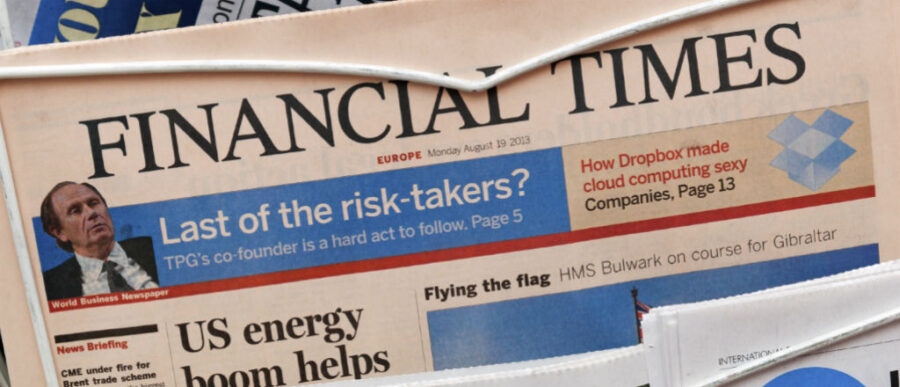The move by Japanese business media group Nikkei to buy the 127 year-old Financial Times newspaper (FT) underscores the fact that the publishing industry’s fortunes lie in going digital as it targets the millennial generation. The deal will also enable a foothold in the U.S. market for Nikkei, Asia’s largest independent media group that has thus far refrained from going global, according to experts. London-based education company Pearson, which owns the FT, announced the $1.3 billion sale last week, saying it planned to focus instead on its core business of “global education strategy.”
“[A] major phenomenon in digital news [is] a tremendous focus on millennials,” said Ken Doctor, a news industry analyst and a contributor to Harvard University’s Nieman Journalism Lab. “This is bigger than a baby boom. You combine that with the business news world and you have millions of people who are young [and] getting into the business world. These are the targets of [a] half-dozen business news companies,” including News Corp., Thomson Reuters and Bloomberg. Doctor is also author of Newsonomics: Twelve New Trends That Will Shape the News You Get (St. Martin’s Press).
“Financial Times has been the leader in managing this [trend towards] digital subscription,” said Wharton management professor Emilie Feldman, whose research interests include corporate strategy and divestitures. She noted that the FT has demonstrated success in converting many digital readers into subscribers when they come up against a pay wall after exhausting their quota of free articles. Given that track record, “Financial Times is probably the right one to be partnered with Nikkei.”
Doctor and Feldman discussed the implications of the FT’s sale for the publishing industry, Pearson and Nikkei on the Knowledge at Wharton show on Wharton Business Radio on SiriusXM channel 111. (Listen to the podcast at the top of this page.)
FT has indeed made some big strides in growing digital revenues. As its total circulation grew more than 30% over the last five years to 737,000, its digital circulation now represents 70% of that total, up from 24% five years ago, according to a press release. Content and services accounted for the majority of its revenues last year ($518 million). That is in contrast to the global publishing industry’s greater reliance on advertising revenues.
Combating Declining Ad Revenues
FT’s success in growing its reader base points the way for the publishing business as advertising revenues become scarce, said Doctor. According to him, The New York Times, which rolled out its pay wall in 2011, now earns “more than $6 out of every $10” from readers. He noted that the Times had modeled its strategy on the FT, which had launched its own pay wall four years earlier. “That is very important in a world where advertising is changing greatly and Google and Facebook are dominating,” he noted. “Reader revenue is absolutely essential because that old advertising world has cratered.”
In coming years, Doctor and Feldman predict that publishing companies will refine their strategies to drive digital readership. “We are very much stuck in this ‘Pay Wall 1.0’ world where [the mode is to] pay a subscription and get everything or 10 articles free a month,” said Doctor. “We’re going to see new developments over the next couple of years to try to get people to pay for smaller streams of content.”
Publishers could offer smaller packages “that are tailored specifically to you and what you want to read,” said Feldman. Doctor added that as digital technology allowed unbundling of content, it would now pave the way for “re-bundling” by publishers, and perhaps even combining multiple content sources. “What if we get Netflix and The New York Times and Time magazine at a price that would be reduced by 15%?” he asked, adding that such an offer “is distinctly possible.”
Good Deal for Both
According to Doctor and Feldman, FT’s deal with Nikkei makes good sense for both parties. “Pearson wanted a good steward for the brand, [and] they badly wanted the money,” Doctor said. Feldman noted that with the FT deal, “Nikkei is clearly buying its growth outside of a slow and shrinking market.”
Pearson could use its net proceeds from the sale (between $650 million and $700 million) to fuel growth in its core education business, Feldman added. Pearson runs standardized test centers and testing processes for GMAT and other examinations worldwide, in addition to running schools and publishing books.
“Nikkei is clearly buying its growth outside of a slow and shrinking market.” –Emilie Feldman
“This is the linchpin of their strategy,” said Feldman of Pearson’s sharpened focus on education. “Now they have the funds to invest in it and to focus their managers’ attention on [education] instead of being distracted by the newspaper business and everything else on the side.”
Doctor wondered if Pearson sold FT a little too early. He explained that the FT Group has outperformed Pearson’s education business in both revenue growth and profit in the last couple of years. That record is “the inverse” of the trend at other media companies like News Corp. and Gannett that, in recent times, have separated their broadcast and publishing businesses, he noted. “[Pearson] could have gotten more in two years had they continued to manage the [FT] business.”
As it happens, Pearson’s sale of the FT to Nikkei does not include its 50% stake in The Economist magazine. Feldman expected that sale to occur in the coming weeks, and Pearson has confirmed that it is in discussions for that. She noted that Pearson’s share in The Economist represents Class-B nonvoting shares, while others investors own the Class-A shares with voting power.
“Anyone who buys Pearson’s 50% stake [in The Economist] is going to be willing to settle for a stake in which they do not have full control over the asset that they are buying,” Feldman said. “Therefore, they might get a lower price for their stake in The Economist.”



